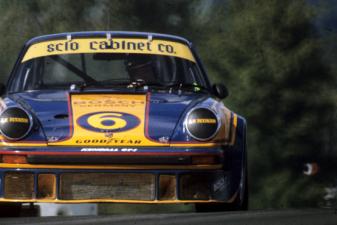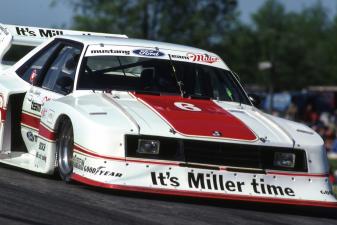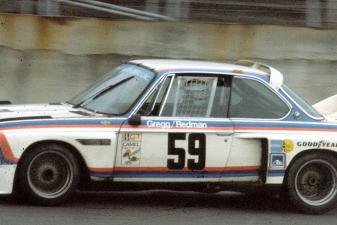IMSA’s All American GT Spices Up the Camel GT Series
An Excerpt from IMSA 1969–1989

The following is an excerpt from the book, IMSA: 1969-1989, by Mitch Bishop and Mark Raffauf.
Porsche’s dominance during the 1974 Camel GT season with the Carrera RSR (the top 10 drivers in the championship all drove Porsches) began to weigh heavily on IMSA founder John Bishop. He wanted to reinvigorate the opportunity for everyday racers to compete at the sharp end of the grid with American-made equipment. Thus, the All American GT concept was born.
(Banner image caption: The first DeKon Monza was campaigned in two races during the 1975 season. Australian Allan Moffat drove it at the Daytona 250-mile finale, on his way to a DNF after completing just fifteen laps. Photo credit: autosportsltd. com)
Porsche’s dominance during the 1974 season began to weigh on John Bishop. He understood the Camel GT Series was not sustainable if it became a one-marque show. And he worried about escalating costs if European manufacturers like Porsche and BMW controlled the supply of the most competitive cars. He wanted to find a way to bring American manufacturers to the front of the grid and offer a cost-effective, competitive product to private teams. But how? The answer came to him on an airplane.
“The old system favored limited production cars like Porsches and BMWs,” John later recounted. “There was no way high volume, cheaper production cars could compete with limited production cars with better components. They were simply better cars. What we needed was an American car that could compete with limited production sports cars from Europe. In the middle of the 1974 season, I was on my way somewhere on an airplane. It occurred to me that Porsche was abusing the FIA Group 5 rules with the turbo-powered 934 and then the 935 with its wilder bodywork. The Group 2 and 4 rules limited what you could do with the bodywork but not so with the Group 5 rules. There was total disregard for the future of the class. We couldn’t ban the Porsches. So, I figured we’ll just do what they’re doing.”
On the airplane, Bishop quickly sketched out his vision for American-based, tube-frame cars powered by readily available, low maintenance V8 engines, a class of cars that would be able to compete with the limited production, high-cost European Porsches and BMWs. He decided to call it All American GT (AAGT).
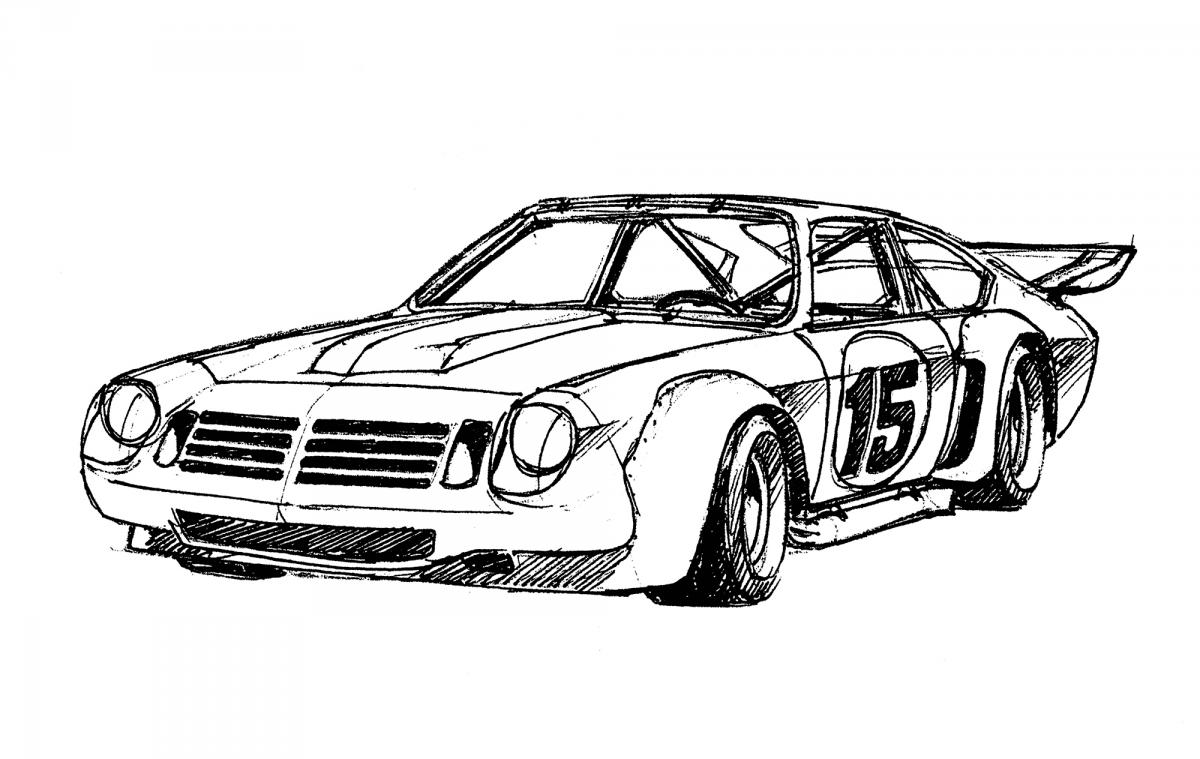 John Bishop’s original sketch of the All American GT concept he made on an airplane in 1974. This first concept drawing turned out to be very close to the first machines built for the AAGT class. Photo credit: Bishop Family.
John Bishop’s original sketch of the All American GT concept he made on an airplane in 1974. This first concept drawing turned out to be very close to the first machines built for the AAGT class. Photo credit: Bishop Family.
“The AAGT class was designed to allow tube-frame American cars to compete with limited production sports cars from Europe,” John recalled. “Porsche 935s were tube-frame cars at the end of the day. The only difference was that they rolled off a special production line in Germany, ready to race. The name AAGT came from our desire to give other people the same advantages that, by stretching the Group 5 rules, Porsche had enjoyed.”
Bishop started to share the AAGT concept in 1974 with some of the top competitors and at the end of the year IMSA published AAGT rules for the 1975 season. Steve Coleman and Amos Johnson debuted the very first AAGT car, a Chevy Vega they had built themselves, at the 1974 Daytona finale, where the car retired after managing just seven laps.
 Steve Coleman and Amos Johnson’s home-built Chevrolet Vega, entered at the Daytona finale in November 1974, was the first AAGT in IMSA. Photo credit: ISC Archives & Research Center/Getty Image
Steve Coleman and Amos Johnson’s home-built Chevrolet Vega, entered at the Daytona finale in November 1974, was the first AAGT in IMSA. Photo credit: ISC Archives & Research Center/Getty Image
“That was one of the overriding happiest reflections on IMSA,” remembered John later. “We could write a set of rules, talk about them with competitors, team owners and the like, publish the rules and then everybody would say; “Yes sir!” And they would go out there and spend money to build a car to those rules. We could create something great from just an idea.”
The new AAGT concept grabbed the attention of car builder and top engineer Lee Dykstra, who entered into a partnership with Horst Kwech in 1974 to form DeKon Engineering with the express purpose of designing, building and selling a competitive AAGT racer. With the direct assistance of Chevrolet, they began taking delivery of engines and other parts to construct the first wave of tube-frame Monzas. At just 2,400 pounds and powered by small block V8s initially using Weber carburetors and later direct fuel injection, they produced 600 to 650bhp, making the Monzas balanced and lightning fast. Purpose-built for racing, the only production parts appeared to be the roof and the windshield.
Kwech, already an accomplished racer, debuted the first production DeKon Monza at the Road Atlanta Camel GT doubleheader in April of 1975. He qualified fifth out of 40 cars entered, which got everyone’s attention, but retired after just 13 laps in the opening heat and didn’t start the second heat the next day due to teething issues. The bright spot was a privately built AAGT Monza driven by Tom Nehl, who finished eighth in both heats. The rest of the paddock began to see the potential of the new cars.
DeKon Engineering continued to develop the car while another, privately-built version of the Monza arrived in the hands of Warren Agor, who finished a respectable 12th and 10th in the two heats at Lime Rock and scored another 10th at Mosport.
It was just a hint of things to come.
The AAGT concept gained speed with Porsche’s focus on the 934 and the Trans-Am for 1976. It put the top IMSA Porsche teams in a bind. Could they be competitive with the now aging Carrera RSR against the BMW CSLs and new AAGT Monzas?
Al Holbert decided the answer was no. Although he had lobbied for the inclusion of the Porsche 934 for 1976, he preferred the larger rear wing, wider rear tires and lighter weight of the Monza compared to the RSR. Holbert purchased a DeKon Monza for the 1976 season and ran his first race at Road Atlanta in April with it after wisely sticking with the more reliable Porsche RSR for the longer Daytona and Sebring rounds. He finished second at the 24 hours of Daytona and won Sebring in March, co-driving with Michael Keyser, who then switched to the Monza.
By the Road Atlanta round in April, eight small block Monzas showed up from three constructors, including examples fielded by Keyser, Agor, Trueman, Nehl, Tom Frank and Jerry Jolly. There were many other AAGT cars as well: Coleman’s original AAGT Vega, five Greenwood- style Corvettes, Charlie Kemp’s wild Cobra II built by Bob Riley, and a host of Camaros led by the big orange No. 21 of Carl Shafer. Holbert and Keyser finished first and second in their DeKon Monzas, humiliating the rest of the field. The AAGT era had officially come of age.
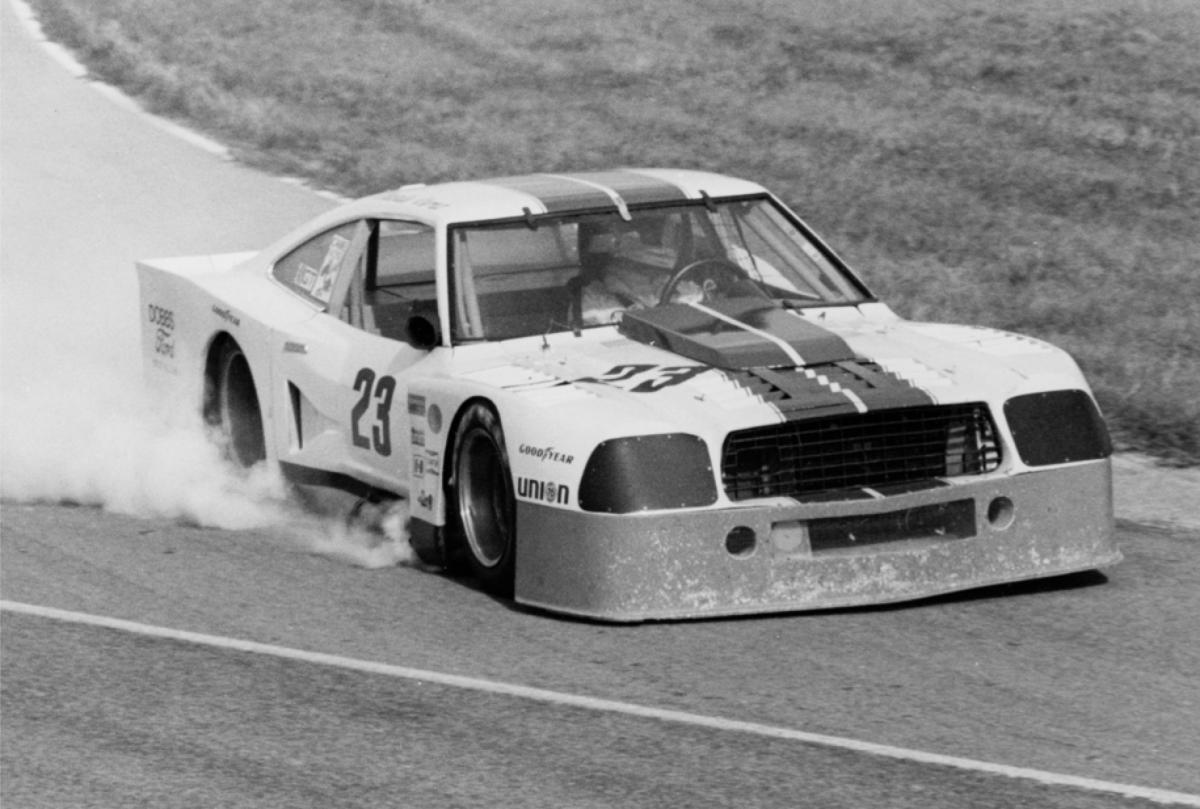 Charlie Kemp’s wild AAGT Cobra II blowing smoke out the exhaust headers at Daytona. IMSA Collection/International Motor Racing Research Center
Charlie Kemp’s wild AAGT Cobra II blowing smoke out the exhaust headers at Daytona. IMSA Collection/International Motor Racing Research Center
Holbert went on to win four more races in the Monza to take the 1976 Camel GT championship. Keyser won two races with his version as well, cementing the future of American-built, tube-frame racers as the equal of anything produced on assembly lines in Europe. The Porsche Carrera RSR contingent included the usual faces along with George Dyer, Roberto Quintanilla, Bob Hagestad, John Gunn, John Graves, Monte Shelton and others.
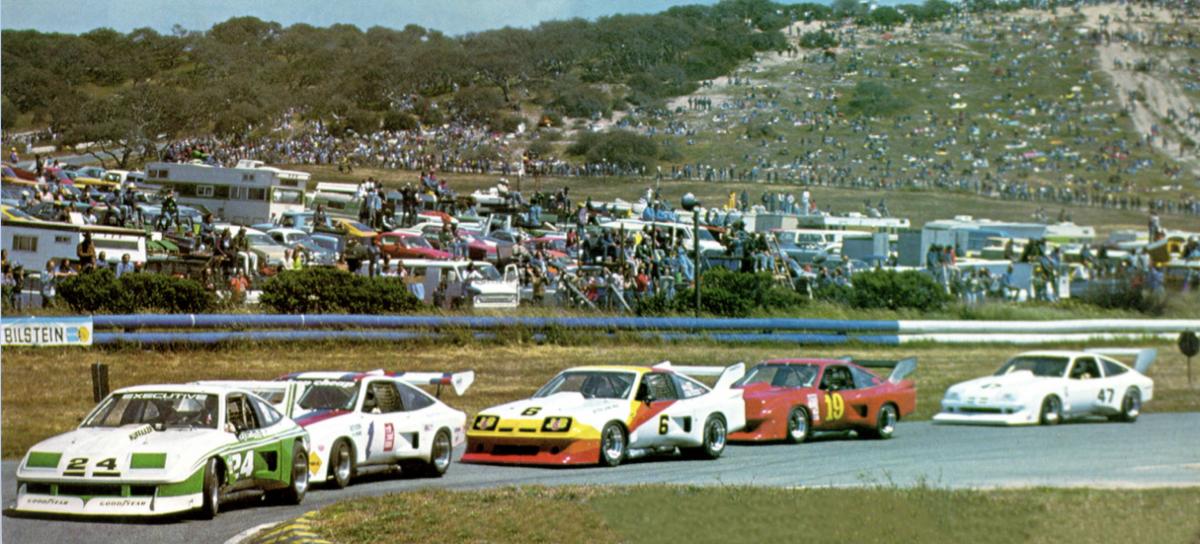 A host of Monzas head into the final turn at Laguna Seca during a heat race in 1977. Tom Frank leads Michael Keyser, Greg Pickett, Chris Cord, and Brad Frisselle, who took delivery of his car right before the race from Keyser and didn’t have time to apply graphics. Photo credit: autosportsltd. com
A host of Monzas head into the final turn at Laguna Seca during a heat race in 1977. Tom Frank leads Michael Keyser, Greg Pickett, Chris Cord, and Brad Frisselle, who took delivery of his car right before the race from Keyser and didn’t have time to apply graphics. Photo credit: autosportsltd. com
The AAGT revolution continued unabated for several years. Holbert won a second championship in a new winged Monza in 1977 against an onslaught of Porsche 934/5s. Other manufacturers became involved in the AAGT class, including Bob Sharp with the Datsun 280ZX twin turbo V8. The bodywork, aero packages and engines got so outrageous that IMSA dropped the AAGT moniker and changed the name of the class to GT eXperimental (GTX) in 1978. GTX became a combined class that included Group 5 Porsche 935s and all manner of AAGT machinery.
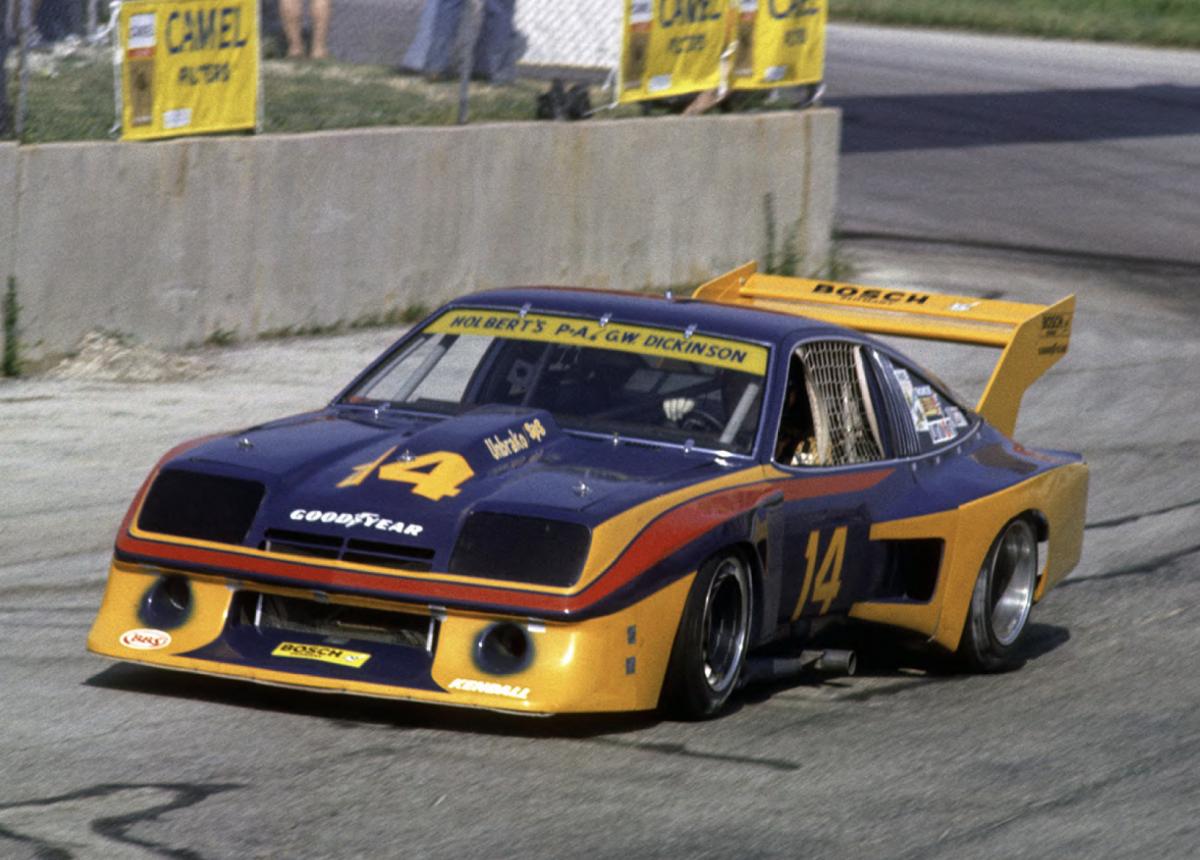 Al Holbert won a second consecutive Camel GT championship in 1977 in his potent AAGT Monza, updated with a larger rear wing, wider wheels, and more generous bodywork modifications that were allowed under new GTX rules. Photo credit: autosportsltd. com
Al Holbert won a second consecutive Camel GT championship in 1977 in his potent AAGT Monza, updated with a larger rear wing, wider wheels, and more generous bodywork modifications that were allowed under new GTX rules. Photo credit: autosportsltd. com
 With rules changes that allowed for wilder bodywork, AAGT machinery continued to compete effectively with the Porsche 935 and the BMW turbo in 1978. Carl Shafer’s Camaro exits from under the bridge at Road Atlanta and starts the downhill plunge to the start/finish line. Photo credit: Bruce Czaja
With rules changes that allowed for wilder bodywork, AAGT machinery continued to compete effectively with the Porsche 935 and the BMW turbo in 1978. Carl Shafer’s Camaro exits from under the bridge at Road Atlanta and starts the downhill plunge to the start/finish line. Photo credit: Bruce Czaja
Stay tuned for more excerpts from our upcoming book, IMSA: 1969-1989, available now for presale!
Porsche’s dominance during the 1974 Camel GT season with the Carrera RSR (the top 10 drivers in the championship all drove Porsches) began to weigh heavily on IMSA founder John Bishop. He wanted to reinvigorate the opportunity for everyday racers to compete at the sharp end of the grid with American-made equipment. Thus, the All American GT concept was born.
(Banner image caption: The first DeKon Monza was campaigned in two races during the 1975 season. Australian Allan Moffat drove it at the Daytona 250-mile finale, on his way to a DNF after completing just fifteen laps. Photo credit: autosportsltd. com)
Porsche’s dominance during the 1974 season began to weigh on John Bishop. He understood the Camel GT Series was not sustainable if it became a one-marque show. And he worried about escalating costs if European manufacturers like Porsche and BMW controlled the supply of the most competitive cars. He wanted to find a way to bring American manufacturers to the front of the grid and offer a cost-effective, competitive product to private teams. But how? The answer came to him on an airplane.
“The old system favored limited production cars like Porsches and BMWs,” John later recounted. “There was no way high volume, cheaper production cars could compete with limited production cars with better components. They were simply better cars. What we needed was an American car that could compete with limited production sports cars from Europe. In the middle of the 1974 season, I was on my way somewhere on an airplane. It occurred to me that Porsche was abusing the FIA Group 5 rules with the turbo-powered 934 and then the 935 with its wilder bodywork. The Group 2 and 4 rules limited what you could do with the bodywork but not so with the Group 5 rules. There was total disregard for the future of the class. We couldn’t ban the Porsches. So, I figured we’ll just do what they’re doing.”
On the airplane, Bishop quickly sketched out his vision for American-based, tube-frame cars powered by readily available, low maintenance V8 engines, a class of cars that would be able to compete with the limited production, high-cost European Porsches and BMWs. He decided to call it All American GT (AAGT).
 John Bishop’s original sketch of the All American GT concept he made on an airplane in 1974. This first concept drawing turned out to be very close to the first machines built for the AAGT class. Photo credit: Bishop Family.
John Bishop’s original sketch of the All American GT concept he made on an airplane in 1974. This first concept drawing turned out to be very close to the first machines built for the AAGT class. Photo credit: Bishop Family.“The AAGT class was designed to allow tube-frame American cars to compete with limited production sports cars from Europe,” John recalled. “Porsche 935s were tube-frame cars at the end of the day. The only difference was that they rolled off a special production line in Germany, ready to race. The name AAGT came from our desire to give other people the same advantages that, by stretching the Group 5 rules, Porsche had enjoyed.”
Bishop started to share the AAGT concept in 1974 with some of the top competitors and at the end of the year IMSA published AAGT rules for the 1975 season. Steve Coleman and Amos Johnson debuted the very first AAGT car, a Chevy Vega they had built themselves, at the 1974 Daytona finale, where the car retired after managing just seven laps.
 Steve Coleman and Amos Johnson’s home-built Chevrolet Vega, entered at the Daytona finale in November 1974, was the first AAGT in IMSA. Photo credit: ISC Archives & Research Center/Getty Image
Steve Coleman and Amos Johnson’s home-built Chevrolet Vega, entered at the Daytona finale in November 1974, was the first AAGT in IMSA. Photo credit: ISC Archives & Research Center/Getty Image“That was one of the overriding happiest reflections on IMSA,” remembered John later. “We could write a set of rules, talk about them with competitors, team owners and the like, publish the rules and then everybody would say; “Yes sir!” And they would go out there and spend money to build a car to those rules. We could create something great from just an idea.”
The new AAGT concept grabbed the attention of car builder and top engineer Lee Dykstra, who entered into a partnership with Horst Kwech in 1974 to form DeKon Engineering with the express purpose of designing, building and selling a competitive AAGT racer. With the direct assistance of Chevrolet, they began taking delivery of engines and other parts to construct the first wave of tube-frame Monzas. At just 2,400 pounds and powered by small block V8s initially using Weber carburetors and later direct fuel injection, they produced 600 to 650bhp, making the Monzas balanced and lightning fast. Purpose-built for racing, the only production parts appeared to be the roof and the windshield.
Kwech, already an accomplished racer, debuted the first production DeKon Monza at the Road Atlanta Camel GT doubleheader in April of 1975. He qualified fifth out of 40 cars entered, which got everyone’s attention, but retired after just 13 laps in the opening heat and didn’t start the second heat the next day due to teething issues. The bright spot was a privately built AAGT Monza driven by Tom Nehl, who finished eighth in both heats. The rest of the paddock began to see the potential of the new cars.
DeKon Engineering continued to develop the car while another, privately-built version of the Monza arrived in the hands of Warren Agor, who finished a respectable 12th and 10th in the two heats at Lime Rock and scored another 10th at Mosport.
It was just a hint of things to come.
The AAGT concept gained speed with Porsche’s focus on the 934 and the Trans-Am for 1976. It put the top IMSA Porsche teams in a bind. Could they be competitive with the now aging Carrera RSR against the BMW CSLs and new AAGT Monzas?
Al Holbert decided the answer was no. Although he had lobbied for the inclusion of the Porsche 934 for 1976, he preferred the larger rear wing, wider rear tires and lighter weight of the Monza compared to the RSR. Holbert purchased a DeKon Monza for the 1976 season and ran his first race at Road Atlanta in April with it after wisely sticking with the more reliable Porsche RSR for the longer Daytona and Sebring rounds. He finished second at the 24 hours of Daytona and won Sebring in March, co-driving with Michael Keyser, who then switched to the Monza.
By the Road Atlanta round in April, eight small block Monzas showed up from three constructors, including examples fielded by Keyser, Agor, Trueman, Nehl, Tom Frank and Jerry Jolly. There were many other AAGT cars as well: Coleman’s original AAGT Vega, five Greenwood- style Corvettes, Charlie Kemp’s wild Cobra II built by Bob Riley, and a host of Camaros led by the big orange No. 21 of Carl Shafer. Holbert and Keyser finished first and second in their DeKon Monzas, humiliating the rest of the field. The AAGT era had officially come of age.
 Charlie Kemp’s wild AAGT Cobra II blowing smoke out the exhaust headers at Daytona. IMSA Collection/International Motor Racing Research Center
Charlie Kemp’s wild AAGT Cobra II blowing smoke out the exhaust headers at Daytona. IMSA Collection/International Motor Racing Research CenterHolbert went on to win four more races in the Monza to take the 1976 Camel GT championship. Keyser won two races with his version as well, cementing the future of American-built, tube-frame racers as the equal of anything produced on assembly lines in Europe. The Porsche Carrera RSR contingent included the usual faces along with George Dyer, Roberto Quintanilla, Bob Hagestad, John Gunn, John Graves, Monte Shelton and others.
 A host of Monzas head into the final turn at Laguna Seca during a heat race in 1977. Tom Frank leads Michael Keyser, Greg Pickett, Chris Cord, and Brad Frisselle, who took delivery of his car right before the race from Keyser and didn’t have time to apply graphics. Photo credit: autosportsltd. com
A host of Monzas head into the final turn at Laguna Seca during a heat race in 1977. Tom Frank leads Michael Keyser, Greg Pickett, Chris Cord, and Brad Frisselle, who took delivery of his car right before the race from Keyser and didn’t have time to apply graphics. Photo credit: autosportsltd. comThe AAGT revolution continued unabated for several years. Holbert won a second championship in a new winged Monza in 1977 against an onslaught of Porsche 934/5s. Other manufacturers became involved in the AAGT class, including Bob Sharp with the Datsun 280ZX twin turbo V8. The bodywork, aero packages and engines got so outrageous that IMSA dropped the AAGT moniker and changed the name of the class to GT eXperimental (GTX) in 1978. GTX became a combined class that included Group 5 Porsche 935s and all manner of AAGT machinery.
 Al Holbert won a second consecutive Camel GT championship in 1977 in his potent AAGT Monza, updated with a larger rear wing, wider wheels, and more generous bodywork modifications that were allowed under new GTX rules. Photo credit: autosportsltd. com
Al Holbert won a second consecutive Camel GT championship in 1977 in his potent AAGT Monza, updated with a larger rear wing, wider wheels, and more generous bodywork modifications that were allowed under new GTX rules. Photo credit: autosportsltd. com With rules changes that allowed for wilder bodywork, AAGT machinery continued to compete effectively with the Porsche 935 and the BMW turbo in 1978. Carl Shafer’s Camaro exits from under the bridge at Road Atlanta and starts the downhill plunge to the start/finish line. Photo credit: Bruce Czaja
With rules changes that allowed for wilder bodywork, AAGT machinery continued to compete effectively with the Porsche 935 and the BMW turbo in 1978. Carl Shafer’s Camaro exits from under the bridge at Road Atlanta and starts the downhill plunge to the start/finish line. Photo credit: Bruce CzajaStay tuned for more excerpts from our upcoming book, IMSA: 1969-1989, available now for presale!


